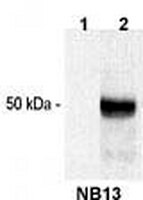NB13 Sigma-AldrichPhosphoDetect™ Anti-Ca2+/Calmodulin Kinase II α-Subunit (pThr²⁸⁶) (Ab-2) Mouse mAb (22B1)
Recommended Products
Overview
| Replacement Information |
|---|
Key Spec Table
| Host |
|---|
| M |
| Product Information | |
|---|---|
| Form | Liquid |
| Formulation | In PBS. |
| Preservative | ≤0.1% sodium azide |
| Physicochemical Information |
|---|
| Dimensions |
|---|
| Materials Information |
|---|
| Toxicological Information |
|---|
| Safety Information according to GHS |
|---|
| Safety Information |
|---|
| Product Usage Statements |
|---|
| Packaging Information |
|---|
| Transport Information |
|---|
| Supplemental Information |
|---|
| Specifications |
|---|
| Global Trade Item Number | |
|---|---|
| Catalogue Number | GTIN |
| NB13 | 0 |
Documentation
PhosphoDetect™ Anti-Ca2+/Calmodulin Kinase II α-Subunit (pThr²⁸⁶) (Ab-2) Mouse mAb (22B1) Certificates of Analysis
| Title | Lot Number |
|---|---|
| NB13 |
References
| Reference overview |
|---|
| Mayford, M., et al. 1996. Science 274, 1678. Lisman, J. 1994. Trends Neurosci. 17, 406. Ochiishi, T., et al. 1994. Brain Res. 659, 179. Hanson, P.I. and Schulman, H. 1992. Annu. Rev. Biochem. 61, 559. Silva, A.J., et al. 1992. Science 257, 201. Erondu, N.E. and Kennedy, M.B. 1985. J. Neurosci. 5, 3270. |








